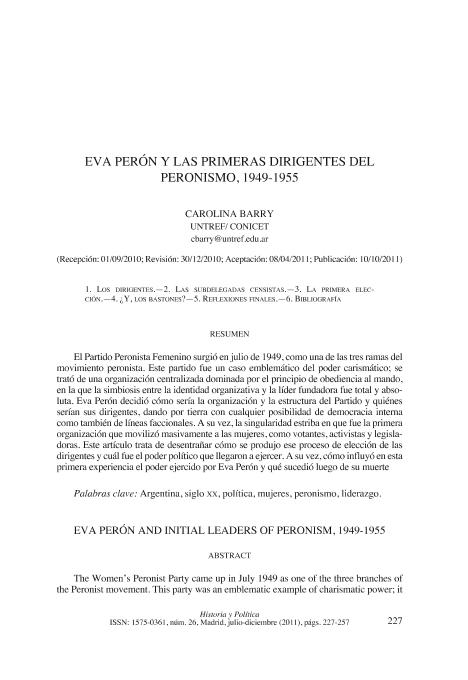Mostrar el registro sencillo del ítem
dc.contributor.author
Barry, Carolina Patricia

dc.date.available
2023-04-05T12:42:01Z
dc.date.issued
2011-10
dc.identifier.citation
Barry, Carolina Patricia; Eva Perón y las primeras dirigentes del peronismo, 1949-1955; Centro de Estudios Políticos y Constitucionales; Historia y Política; 26; 10-2011; 227-257
dc.identifier.issn
1575-0361
dc.identifier.uri
http://hdl.handle.net/11336/192809
dc.description.abstract
El Partido Peronista Femenino surgió en julio de 1949, como una de las tres ramas del movimiento peronista. Este partido fue un caso emblemático del poder carismático; se trató de una organización centralizada dominada por el principio de obediencia al mando, en la que la simbiosis entre la identidad organizativa y la líder fundadora fue total y absoluta. Eva Perón decidió cómo sería la organización y la estructura del Partido y quiénes serían sus dirigentes, dando por tierra con cualquier posibilidad de democracia interna como también de líneas faccionales. A su vez, la singularidad estriba, en que fue la primera organización que movilizó masivamente a las mujeres, como votantes, activistas y legisladoras. Este artículo trata de desentrañar cómo se produjo ese proceso de elección de las dirigentes y cuál fue el poder político que llegaron a ejercer. A su vez, cómo influyó en esta primera experiencia el poder ejercido por Eva Perón y qué sucedió luego de su muerte.
dc.description.abstract
The Women’s Peronist Party came up in July 1949 as one of the three branches of the Peronist movement. This party was an emblematic example of charismatic power; it was a centralized organization ruled by the principle of obedience to the leader, where the symbiosis between the organizational identity and the founding leader was absolute. Eva Perón decided which was going to be the organization and structure of the Party and who would occupy the leadership posts. In this way, there was not any space for internal democracy or for splinter groups. At the same time, this was the very first organization that assembled the women as voters, activists and legislators. This article tries to figure out how the election processes for the leadership posts were and which was the political power that the chosen leaders could exercise. In addition, how much influence did the power of Eva Perón signified to the party and what happened after her death.
dc.format
application/pdf
dc.language.iso
spa
dc.publisher
Centro de Estudios Políticos y Constitucionales
dc.rights
info:eu-repo/semantics/openAccess
dc.rights.uri
https://creativecommons.org/licenses/by-nc-nd/2.5/ar/
dc.subject
ARGENTINA
dc.subject
SIGLO XX
dc.subject
POLÍTICA
dc.subject
MUJERES
dc.subject
PERONISMO
dc.subject
LIDERAZGO
dc.subject.classification
Otras Ciencia Política

dc.subject.classification
Ciencia Política

dc.subject.classification
CIENCIAS SOCIALES

dc.title
Eva Perón y las primeras dirigentes del peronismo, 1949-1955
dc.title
Eva Perón and initial leaders of peronism, 1949-1955
dc.type
info:eu-repo/semantics/article
dc.type
info:ar-repo/semantics/artículo
dc.type
info:eu-repo/semantics/publishedVersion
dc.date.updated
2023-04-04T12:03:55Z
dc.journal.number
26
dc.journal.pagination
227-257
dc.journal.pais
España

dc.journal.ciudad
Madrid
dc.description.fil
Fil: Barry, Carolina Patricia. Consejo Nacional de Investigaciones Científicas y Técnicas; Argentina. Universidad Nacional de Tres de Febrero; Argentina
dc.journal.title
Historia y Política
dc.relation.alternativeid
info:eu-repo/semantics/altIdentifier/url/https://recyt.fecyt.es/index.php/Hyp/article/view/41332
Archivos asociados
